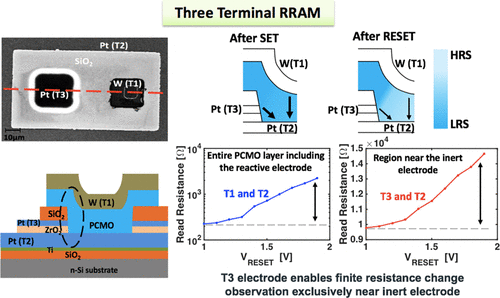当前位置:
X-MOL 学术
›
ACS Appl. Electron. Mater.
›
论文详情
Our official English website, www.x-mol.net, welcomes your feedback! (Note: you will need to create a separate account there.)
Understanding the Region of Resistance Change in Pr0.7Ca0.3MnO3 RRAM
ACS Applied Electronic Materials ( IF 4.7 ) Pub Date : 2020-06-28 , DOI: 10.1021/acsaelm.0c00297 Sandip Lashkare 1 , Vivek Saraswat 1 , Udayan Ganguly 1
ACS Applied Electronic Materials ( IF 4.7 ) Pub Date : 2020-06-28 , DOI: 10.1021/acsaelm.0c00297 Sandip Lashkare 1 , Vivek Saraswat 1 , Udayan Ganguly 1
Affiliation

|
Pr1–xCaxMnO3 (PCMO)-based resistance random access memory (RRAM) is attractive in large-scale memory and neuromorphic applications as it is nonfilamentary and area scalable and has multiple resistance states along with excellent endurance and retention. The PCMO RRAM exhibits area-scalable resistive switching when in contact with the reactive electrode. The interface redox reaction-based resistance switching is observed electrically. Yet, whether the resistance change occurs near the reactive interface or spread over the entire bulk is largely debated. Essentially, a two-terminal device is unable to provide direct evidence of the resistance change region in the PCMO RRAM. In this paper, we propose and experimentally demonstrate a three-terminal RRAM (3T-RRAM) device in which a thin third terminal (∼20 nm) is inserted laterally in close proximity to a typical vertical two-terminal RRAM device of PCMO thickness ∼80 nm. It is well known that the reactive interface participates in the resistive switching. However, using the 3T-RRAM, we demonstrate that the resistance change also occurs in the region near the inert electrode. We further show that the resistance measured by T3 is exclusively sensitive to the region near the inert electrode as opposed to the reactive electrode. Finally, the highly symmetric space charge limited current (SCLC) characteristics with polarity at various resistance levels, typical of two-terminal RRAM, are undisturbed because of the slightly adjacent placement of the nanoscale inert third terminal while providing resistance change read sensitivity. It is the first time that an interface redox and bulk SCLC-based resistance change has been experimentally shown as correlated and consistent, enabled by the third terminal of the RRAM. Such a study details a critical understanding of the device which can enable the design and development of PCMO RRAM for large memory and neuromorphic computing applications.
中文翻译:

了解Pr 0.7 Ca 0.3 MnO 3 RRAM中电阻变化的区域
Pr 1– x Ca x MnO 3基于(PCMO)的电阻随机存取存储器(RRAM)具有非丝状和面积可扩展性,并具有多种电阻状态以及出色的耐久性和保持性,因此在大规模存储器和神经形态应用中具有吸引力。与反应电极接触时,PCMO RRAM表现出面积可缩放的电阻切换。电观察到基于界面氧化还原反应的电阻切换。然而,电阻变化是发生在电抗性界面附近还是散布在整个主体上的争论很大。本质上,两端子设备无法提供PCMO RRAM中电阻变化区域的直接证据。在本文中,我们提出并通过实验证明了一种三端RRAM(3T-RRAM)器件,其中一个薄的第三端(〜20 nm)横向插入到PCMO厚度约为80 nm的典型垂直两端RRAM器件附近。众所周知,电抗性接口参与电阻切换。但是,使用3T-RRAM,我们证明在惰性电极附近的区域中也会发生电阻变化。我们进一步表明,由T3测量的电阻仅对惰性电极附近的区域敏感,而与反应电极相反。最后,高度对称的空间电荷限制电流(SCLC)特性在两个电阻RRAM典型的各种电阻水平下具有极性,由于纳米级惰性第三端子的位置略微相邻,同时提供了电阻变化的读取灵敏度,因此不受干扰。这是第一次通过RRAM的第三端通过实验证明界面氧化还原和基于SCLC的整体电阻变化是相关且一致的。这项研究详细说明了对该设备的批判性理解,可以使PCMO RRAM的设计和开发适用于大内存和神经形态计算应用。
更新日期:2020-07-28
中文翻译:

了解Pr 0.7 Ca 0.3 MnO 3 RRAM中电阻变化的区域
Pr 1– x Ca x MnO 3基于(PCMO)的电阻随机存取存储器(RRAM)具有非丝状和面积可扩展性,并具有多种电阻状态以及出色的耐久性和保持性,因此在大规模存储器和神经形态应用中具有吸引力。与反应电极接触时,PCMO RRAM表现出面积可缩放的电阻切换。电观察到基于界面氧化还原反应的电阻切换。然而,电阻变化是发生在电抗性界面附近还是散布在整个主体上的争论很大。本质上,两端子设备无法提供PCMO RRAM中电阻变化区域的直接证据。在本文中,我们提出并通过实验证明了一种三端RRAM(3T-RRAM)器件,其中一个薄的第三端(〜20 nm)横向插入到PCMO厚度约为80 nm的典型垂直两端RRAM器件附近。众所周知,电抗性接口参与电阻切换。但是,使用3T-RRAM,我们证明在惰性电极附近的区域中也会发生电阻变化。我们进一步表明,由T3测量的电阻仅对惰性电极附近的区域敏感,而与反应电极相反。最后,高度对称的空间电荷限制电流(SCLC)特性在两个电阻RRAM典型的各种电阻水平下具有极性,由于纳米级惰性第三端子的位置略微相邻,同时提供了电阻变化的读取灵敏度,因此不受干扰。这是第一次通过RRAM的第三端通过实验证明界面氧化还原和基于SCLC的整体电阻变化是相关且一致的。这项研究详细说明了对该设备的批判性理解,可以使PCMO RRAM的设计和开发适用于大内存和神经形态计算应用。



























 京公网安备 11010802027423号
京公网安备 11010802027423号